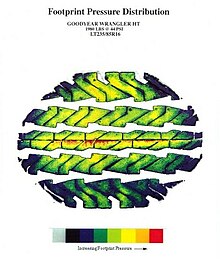Number Twelve
Well-Known Member
- Joined
- August 31, 2015
- Messages
- 487
- Reaction score
- 80
- City, State
- 15 miles west of Tampa Florida
- Year, Model & Trim Level
- 2005 Ford Explorer XLT
Junkyard tires with about half their original tread, 255/70/R16 ($25 each, mounted and balanced  ) on a 2005 Explorer XLT (Beats the H out of $600 and up for a set of 4 tires!)
) on a 2005 Explorer XLT (Beats the H out of $600 and up for a set of 4 tires!)
Car rated as 4469 lbs, tires rated at 2271 pounds each @ 44 P.S.I.
The, "math", pressure proportional to the actual load, shows me at about 21.6 PSI, but the front is obviously heavier than the rear,
plus, I only installed the front two seats.
Running empty, pretending it's a minivan in the rear.
If I figure 169 pounds for the missing 5 seats that makes the weight a nice round 4300 pounds.
So, if the weight distribution is 60/40 that makes the tire pressure calculate to:
25 psi front and 16.7 psi rear
This seems absurd to me.
Anybody know the limits for this application?
Yeah, I know, get the right tires.
But until then...any solid math to work with?
Right now I have them at 35 front and 30 rear, and they show too much belly out in the contact patch.
I'm afraid to let them down until the contact patch is right...or is that the ultimate way to find the right pressure?
 ) on a 2005 Explorer XLT (Beats the H out of $600 and up for a set of 4 tires!)
) on a 2005 Explorer XLT (Beats the H out of $600 and up for a set of 4 tires!)Car rated as 4469 lbs, tires rated at 2271 pounds each @ 44 P.S.I.
The, "math", pressure proportional to the actual load, shows me at about 21.6 PSI, but the front is obviously heavier than the rear,
plus, I only installed the front two seats.
Running empty, pretending it's a minivan in the rear.
If I figure 169 pounds for the missing 5 seats that makes the weight a nice round 4300 pounds.
So, if the weight distribution is 60/40 that makes the tire pressure calculate to:
25 psi front and 16.7 psi rear
This seems absurd to me.

Anybody know the limits for this application?
Yeah, I know, get the right tires.
But until then...any solid math to work with?

Right now I have them at 35 front and 30 rear, and they show too much belly out in the contact patch.
I'm afraid to let them down until the contact patch is right...or is that the ultimate way to find the right pressure?







